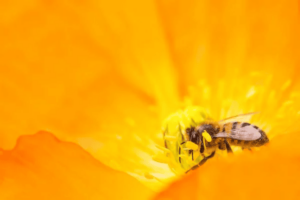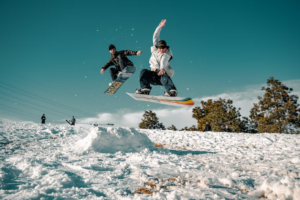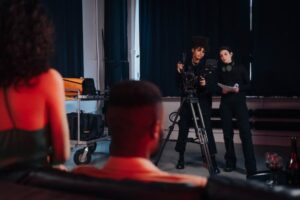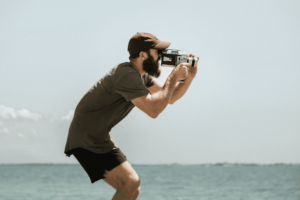An aerial shot is a classic camera angle captured from an elevated vantage point. Aerial photographs present a deeper understanding of the action happening below from a bird’s eye view. This requires specific camera equipment, which usually involves the camera placed on an elevated platform, floating object, or aircraft.

Other Names:
- Bird’s eye view shot
- God’s eye view shot
- Aerial View
- Overhead Shot
- Elevated Shot
- Raised Shot
History of Aerial Photography
In the history of aerial photography, airborne cameras have captured excellent images of natural disasters and combat. The cameras were launched into the sky using kites, balloons, and even rockets. In 1858, the first successful aerial photograph was taken from a hot air balloon at 262 feet over Petit-Bicêtre by Gaspar Felix Tournachon, commonly known as ‘Nadar’. However, the original images taken by him were lost. The oldest aerial photograph available is taken in 1860 by James Wallace Black, 2000 feet above Boston from a tethered hot air balloon, Queen of the Air.

Later, George Lawrence perfected taking aerial shots by strapping large-format cameras with curved film plates to kites. Using this method, he captured the most famous photograph during the 1906 San Francisco earthquake and fire by suspending 17 kites at 2000 feet in the air.

During this period, aerial photographers elsewhere in the world were experimenting with other methods. In 1903, Alfred Maul, a German Engineer, demonstrated a gunpowder rocket that could reach 2600 feet in eight seconds would jettison a parachute equipped with a camera and capture images during its descent. During the same year, Julius Neubronner, a German Apothecary, who was curious about the whereabouts of his prescription-delivering pigeons, strapped cameras to the pigeons to track their routes. He also used his pigeons to capture images of the 1909 Dresden International Photographic Exhibition.

Some years after the first flight of the Wright Brothers in 1903 at Kitty Hawk, piloted and powered aircraft were used for aerial photography for the first time. In 1908, L.P. Bonvillain, a Cinematographer, captured the first known photo from an airplane over Le Mans in France, piloted by Wilbur Wright.
Aerial Shots During World War I
World War I consumed the world shortly after that. Military commanders soon recognized the potential advantage of up-to-date aerial photographs of the battlefield. Cameras were equipped on all types of aircraft, and the wartime practice of aerial survey was born. Later advancements in aviation and photography meant that flight crews could go farther and come back with more valuable images. They are used to reveal enemy movements or plan future attacks.
Aerial Footage of WWI Battlefields – 1919
Aerial Shots During World War II
During World War II, wartime aerial images and video became commonplace in newspapers, magazines, and movie theater newsreels on the Homefront. For example, Margaret Bourke-White, a famous LIFE photographer, became “the first woman ever to fly with a U.S. combat crew over enemy soil” when she covered the U.S. attack on Tunis, as the magazine declared on its March 1, 1943, issue. During this conflict, the U.S. began experimenting with rudimentary drone aircraft, like the TDR-1, though that was an attack aircraft rather than an imaging platform.
There were further advancements in aerial photography with the end of World War II and the Cold War, mainly thanks to the Space Race. On October 24, 1946, the first known photo from space depicting a glimpse of Earth was found from a captured Nazi rocket launched from New Mexico. The efforts of the United States and the Soviet Union’s to outpace each other in aerospace achievements led to advancing satellite images, the ultimate in unmanned aerial photography. Such technology’s power to spy on opponents or help in warning about the incoming nuclear attacks was used by the leaders of that era. According to the Union of Concerned Scientists, today, more than 1,700 satellites orbiting the Earth are used for surveillance, weather forecasting, and more.
Aerial Shots of Bombing – 1944
Rise of Drones
In the 1980s, the first modern-style drones emerged, as Israeli engineers produced models equipped with video cameras that could monitor for hours at a time. After that, the U.S. adopted a similar technology and developed a remote-controlled Pioneer drone during the first Gulf War that filmed Iraqi soldiers surrendering to the USA. Israeli-invented Predator drone was popular during the Afghanistan and Iraq wars because of the ability to hover over areas for a long period. It was helpful to monitor the everyday routine of possible targets. The U.S. military used smaller, hand-launched drones such as the RQ-Raven, which helped the soldiers with an overhead look at potential dangers. New hardware and software such as stabilizers, autopilot, and collision detection systems have given rise to store-bought drones from companies including Parrot and DJI with high-resolution cameras.

Today’s everyday drones are so remarkable. A few years ago, aerial photography was pursued mainly by the military, dedicated hobbyists, and those with access to full-size aircraft. Store-bought drones available today are comparatively cheaper, capturing high-quality images and video. They are also easy to learn to fly, which has led to an outburst in aerial photography. Now Aerial shots are used for commercial uses, including real estate brokers taking eye-catching photos of the houses they are trying to sell, to artistic expressions, such as taking stunning images of forests and cities to post on Instagram. Though technology has changed dramatically over time, the human desire to see the world from above remained constant.
Aerial Shots in Films:
In films, aerial shots can be shot using,
- Plane
- Crane
- Drone
- Helicopter
These types of equipment are often celebrated for their ability to capture from a new vantage point and reveal our planet’s beauty from high above. Aerial shots are from a vantage point which we seldom see in our daily life. This enables the director to produce a unique experience for his viewers.
Earlier, aerial shots were only limited to huge budgeted Hollywood productions that could afford a helicopter or a crane to shoot. However, the presence of drones has made aerial shots much more accessible and feasible.
Aerial shots are often used in crime films. The most standard aerial shot is an establishing shot which is arbitrary without deeper meaning. In the movie, Zodiac, the scene where the killer drives a taxi shows a God’s eye view shot of the killer.
Zodiac – Great Bird’s Eye Shot
In this scene, there is a juxtaposition of the audio in the radio program and the controlled driving without any swerving or speeding. On the radio people are theorizing about what is driving the serial killer when we see him driving.
The Anatomy of an Aerial Shot
The aerial shot could establish where the film takes place and even establish who a character will face. However, for obvious reasons, the aerial shot takes a lot of planning. The planning of a complex scene involving an aerial shot is a thrill in itself. A lot of choreographing and planning is involved, with a bunch of moving parts and objects. The planning of these shots requires extra steps to consider lengthy shot preparation and shoot times. Aerial Shots can be used in movie posters.

Aerial Shots can be used as establishing spots. For instance, in the movie Black Hawk Down, the helicopter scenes show the location of things.
Black Hawk Down Establishing Aerial Shot
Establishing Shots Compilation
Tips on Drone Cinematography:
There are some essential drones shot techniques and tips that will help elevate your drone cinematography.
- Shoot at the best time of day
Since aerial cinematography is used for outside shots, the golden hour will provide the most suitable lighting for such shots.
- ND filter
Usage of ND filters will enable you to shoot at a cinematic shutter speed. That will help in pairing drone shots to the other shots.
- Slow movements
The best way to use drone shots is with slow camera movement. Fast-moving drone shots tend to end in jolty and shaking images that can lower the final video quality. A slow drone shot captured will aid in achieving a more cinematic shot.
- Color grading
Color grade is required to match the drone shots to other cameras used to film the footage.
- Addition of zoom
Applying a zoom will help you add depth to a shot and make the image more engaging and appealing.
Examples of the Best Aerial Shots in Films
Zodiac(2007, David Fincher)
This scene was a breakthrough moment in using computer-generated images for many filmmakers to create imaginative realism. This sequence looks a little bit CG, which at the time was mind-blowing.
Skyfall (2012, Sam Mendes)
Due to drone photography, the previously impossible aerial shots dispersed throughout the sequence were perfectly brought to life. This aids with more adrenaline to an already action-packed scene.
Birdman (2015, Alejandro González Iñárritu)
The flight scene is a marvel of clever planning, composition, and a perfect combination of static and mobile cranes. Despite perfectly capturing the feeling of flying through the air, the cameras never actually left the ground. The illusion of using aerial photography in New York City Street is as distinct as the illusion of flight itself.
Jurassic World (Colin Trevorrow, 2015)
The terrifying moment when a horde of dinosaurs descends the main street of a crowded theme park is purely a mastery of various modern technologies. The use of drones and the dinosaur CG resulted in an incredible and more dynamic shooting than any previous Jurassic film.
Star Wars: The Force Awakens (J. J. Abrams, 2015)
Star Wars The Force Awakens Millennium Falcon Scene
The dynamic aerial shot, fully CG, is blended with digital structures like the ruined destroyer by the visual effects artists.















